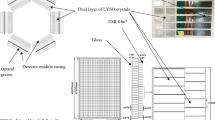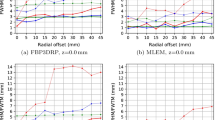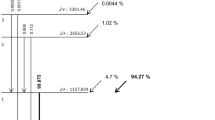Abstract
Purpose
SimPET/M7 system is a small-animal dedicated simultaneous positron emission tomography and magnetic resonance imaging (PET/MRI) scanner. The SimPET insert has been upgraded from its prototype with a focus on count rate performance and sensitivity. The M7 scanner is a 1-T permanent magnet-based compact MRI system without any cryogens. Here, we present performance evaluation results of SimPET along with the results of mutual interference evaluation and simultaneously acquired PET/MR imaging.
Procedures
Following NEMA NU 4-2008 standard, we evaluated the performance of the SimPET system. The M7 MRI compatibility of SimPET was also assessed by analyzing MRI images of a uniform phantom under different PET conditions and PET count rates with different MRI pulse sequences. Mouse imaging was performed including a whole-body 18F-NaF PET scan and a simultaneous PET/MRI scan with 64Cu-NOTA-ironoxide.
Results
The spatial resolution at center based on 3D OSEM without and with warm background was 0.7 mm and 1.45 mm, respectively. Peak sensitivity was 4.21 % (energy window = 250–750 keV). The peak noise equivalent count rate with the same energy window was 151 kcps at 38.4 MBq. The uniformity was 4.42 %, and the spillover ratios in water- and air-filled chambers were 14.6 % and 12.7 %, respectively. In the hot rod phantom image, 0.75-mm-diameter rods were distinguishable. There were no remarkable differences in the SNR and uniformity of MRI images and PET count rates with different PET conditions and MRI pulse sequences. In the whole-body 18F-NaF PET images, fine skeletal structures were well resolved. In the simultaneous PET/MRI study with 64Cu-NOTA-ironoxide, both PET and MRI signals changed before and after injection of the dual-modal imaging probe, which was evident with the exact spatiotemporal correlation.
Conclusions
We demonstrated that the SimPET scanner has a high count rate performance and excellent spatial resolution. The combined SimPET/M7 enabled simultaneous PET/MR imaging studies with no remarkable mutual interference between the two imaging modalities.






Similar content being viewed by others
References
Rudin M, Weissleder R (2003) Molecular imaging in drug discovery and development. Nat Rev Drug Discov 2:123–131
Koo V, Hamilton PW, Williamson K (2006) Non-invasive in vivo imaging in small animal research. Cell Oncol 28:127–139
Kim C, Chen Z (2018) Multimodal photoacoustic imaging: systems, applications, and agents. Biomed Eng Lett 8:137–138
Son H, Jang K, Lee H, Kim SE, Kang KW, Lee H (2019) Use of molecular imaging in clinical drug development: a systematic review. Nucl Med Mol Imaging 53:208–215
Choi WJ (2019) Optical coherence tomography angiography in preclinical neuroimaging. Biomed Eng Lett 9:311–325
Cassidy PJ, Radda GK (2005) Molecular imaging perspectives. J R Soc Interface 2:133–144
Pichler BJ, Wehrl HF, Judenhofer MS (2008) Latest advances in molecular imaging instrumentation. J Nucl Med 49:5S–23S
Vaska P, Rubins DJ, Alexoff DL, Schiffer WK (2006) Quantitative imaging with the micro-PET small-animal PET tomograph. Int Rev Neurobiol 73:191–218
Antoch G, Bockisch A (2009) Combined PET/MRI: a new dimension in whole-body oncology imaging? Eur J Nucl Med Mol Imaging 36(Suppl 1):S113–S120
Jadvar H, Colletti PM (2014) Competitive advantage of PET/MRI. Eur J Radiol 83:84–94
Yoo HJ, Lee JS, Jee JM (2015) Integrated whole body PET/MRI: where are we? Korean J Radiol 16:32–49
Lee DS (2019) Clinical personal connectomics using hybrid PET/MRI. Nucl Med Mol Imaging 53:153–163
Judenhofer MS, Wehrl HF, Newport DF, et al (2008) Simultaneous PET-MRI: a new approach for functional and morphological imaging. Nat Med 14:459–465
Schlemmer HPW, Pichler BJ, Schmand M, et al (2008) Simultaneous MR/PET imaging of the human brain: feasibility study. Radiology 248:1028–1035
Catana C, Drzezga A, Heiss W-D, Rosen BR (2012) PET/MRI for neurologic applications. J Nucl Med 53:1916–1925
Yoon HS, Ko GB, Kwon SI, et al (2012) Initial results of simultaneous PET/MRI experiments with an MRI-compatible silicon photomultiplier PET scanner. J Nucl Med 53:608–614
Omidvari N, Cabello J, Topping G et al (2017) PET performance evaluation of MADPET4: a small animal PET insert for a 7T MRI scanner. Phys Med Biol 62:8617–8692
Stortz G, Thiessen JD, Bishop D et al (2018) Performance of a PET insert for high-resolution small-animal PET/MRI at 7 tesla. J Nucl Med 59:536–542
Hallen P, Schug D, Weissler B et al (2018) PET performance evaluation of the small-animal Hyperion IID PET/MRI insert based on the NEMA NU-4 standard. Biomed Phys Eng Express 4:065027
Yamamoto S, Watabe T, Watabe H, et al (2012) Simultaneous imaging using Si-PM-based PET and MRI for development of an integrated PET/MRI system. Phys Med Biol 57:N1–N13
Chang CM, Lee BJ, Grant AM, Groll AN, Levin CS (2018) Performance study of a radio-frequency field-penetrable PET insert for simultaneous PET/MRI. IEEE Trans Radiat Plasma Med Sci 2:422–431
Belcari N, Bisogni MG, Camarlinghi N et al (2019) Design and detector performance of the PET component of the TRIMAGE PET/MR/EEG scanner. IEEE Trans Radiat Plasma Med Sci 3:292–3011
Gonzalez AJ, Gonzalez-Montoro A, Vidal LF et al (2019) Initial results of the MINDView PET insert inside the 3T mMR. IEEE Trans Radiat Plasma Med Sci 3:343–351
Ko GB, Yoon HS, Kim KY, et al (2016) Simultaneous multi-parametric PET/MRI with silicon photomultiplier PET and ultra-high field MRI for small animal imaging. J Nucl Med 57:1309–1315
Ko GB, Kim KY, Yoon HS et al (2016) Evaluation of a silicon photomultiplier PET insert for simultaneous PET and MR imaging. Med Phys 43:72–83
National Electrical Manufacturers Association (2007) NEMA standards publication NU 2–2007: performance measurements of positron emission tomographs. National Electrical Manufacturers Association, Rosslyn
Peng BJ, Wu Y, Cherry SR, Walton JH (2014) New shielding configurations for a simultaneous PET/MRI scanner at 7T. J Magn Reson 239:50–56
Yoon HS, Lee JS (2014) Bipolar analog signal multiplexing for position-sensitive PET block detectors. Phys Med Biol 59:7835–7846
Son J-W, Won JY, Lee JS (2017) Evaluation of a FPGA-based real-time coincidence system for high count rate PET scanners. IEEE Nucl Sci Sym Med Imaging Conf Conference Record. https://doi.org/10.1109/NSSMIC.2017.8533051
Panin VY, Kehren F, Michel C, Casey M (2006) Fully 3-D PET reconstruction with system matrix derived from point source measurements. IEEE Trans Med Imaging 25:907–921
Uppal R, Catana C, Ay I, Benner T, Sorensen AG, Caravan P (2011) Bimodal thrombus imaging: simultaneous PET/MR imaging with a fibrin-targeted dual PET/MR probe—feasibility study in rat model. Radiology 258:812–820
Ng TSC, Bading JR, Park R, et al (2012) Quantitative, simultaneous PET/MRI for intratumoral imaging with an MRI-compatible PET scanner. J Nucl Med 53:1102–1109
Goldenberg JM, Cardenas-Rodriguez J, Pagel MD (2018) Preliminary results that assess metformin treatment in a preclinical model of pancreatic cancer using simultaneous [18F]FDG PET and acidoCEST MRI. Mol Imaging Biol 20:575–583
Funding
This work was supported in part by grants from the Seoul National University Creative Factory funded by the Korean Ministry of SMEs and Startups (grant no. 10080715).
Author information
Authors and Affiliations
Corresponding authors
Ethics declarations
Ethical Approval
All animal experiments were approved by the Institutional Animal Care and Use Committee at the Seoul National University Hospital.
Conflict of Interest
J-W Son, KY Kim, K Kim, GB Ko, and JS Lee are employees of Brightonix Imaging Inc.
Additional information
Publisher’s Note
Springer Nature remains neutral with regard to jurisdictional claims in published maps and institutional affiliations.
Electronic Supplementary Material
ESM 1
(DOCX 147 kb)
Rights and permissions
About this article
Cite this article
Son, JW., Kim, K.Y., Park, J.Y. et al. SimPET: a Preclinical PET Insert for Simultaneous PET/MR Imaging. Mol Imaging Biol 22, 1208–1217 (2020). https://doi.org/10.1007/s11307-020-01491-y
Published:
Issue Date:
DOI: https://doi.org/10.1007/s11307-020-01491-y




